Samodelkin - almost like Homer. Seven ancient cities argued for the right to be called the homeland of a blind storyteller. There are fewer applicants for the title of creator of Samodelkin, but also enough.
Even the main source of knowledge about the modern world - Wikipedia in the article "Samodelkin" most recently recently quoted two names at once.
At first she claimed:
The character was invented by the Soviet artist and animated film director Vakhtang Bakhtadze.and later clarified:
In the early 1960s, the books of the writer Yuri Druzhkov were published, who, using the idea of V.D. Bakhtadze, made the main character of his books Samodelkin and his friend, Pencil.Behind all this, Samodelkin’s true homeland, the Funny Pictures magazine, was somehow lost.
What really happened?
In fact, the real creator of the image of Samodelkin known to us is the artist Anatoly Sazonov, who invented and painted it for the magazine "Funny Pictures" in mid-1958. Here is the author’s image of this character.
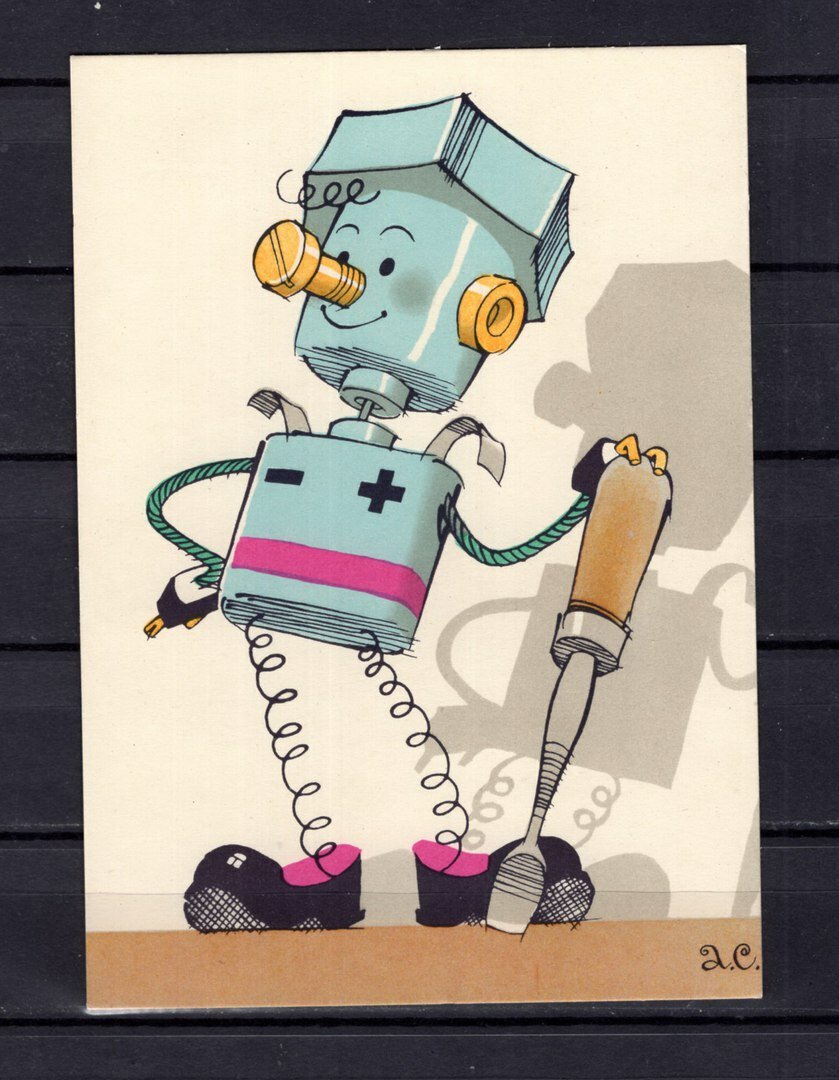
The date is set fairly accurately because at the beginning of 1958 there were only five cheerful little men - Pencil, Pinocchio, Cipollino, Gurvinek and Petrushka. Here, for example, is a drawing of the famous artist (and the chief editor of the magazine) Ivan Semenov from the January issue:

And here is the page from the July issue. Pay attention to the frame.
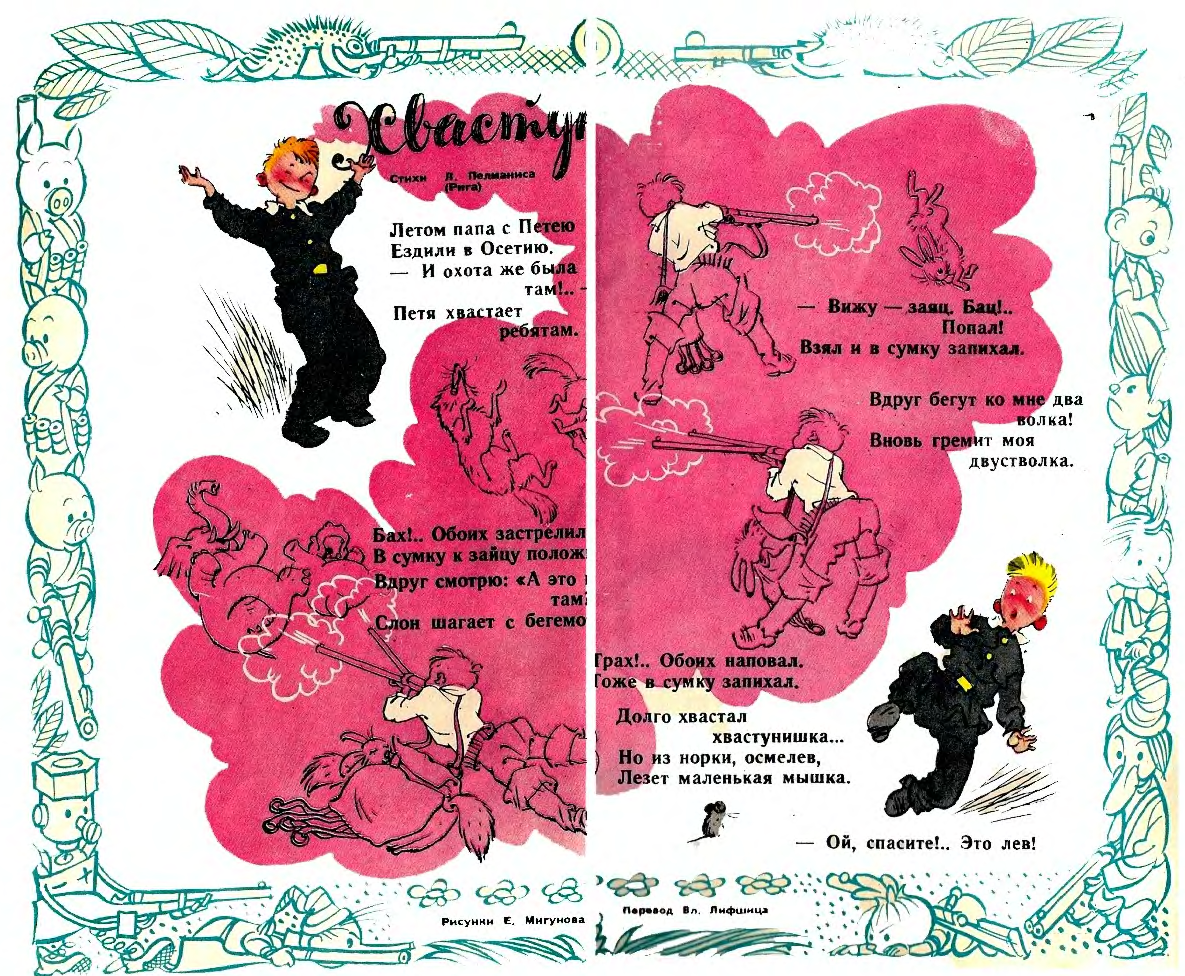
As we can see, the 4-year-old then-Dunno, who was invented specially for the magazine Samodelkin, was rapidly added to the company. Later Thumbelina will join them in order to dilute the exclusively male company, and this will be the canonical composition of the Club of Cheerful Men.

Where did the “Georgian version” come from? The fact is that in 1957, the Georgian animator Vakhtang Bakhtadze invented a robot assembled from the details of the designer, and called it "Samodelkin." Here's what he looked like - a completely Georgian-looking mechanical man in the famous Svanuri hat.
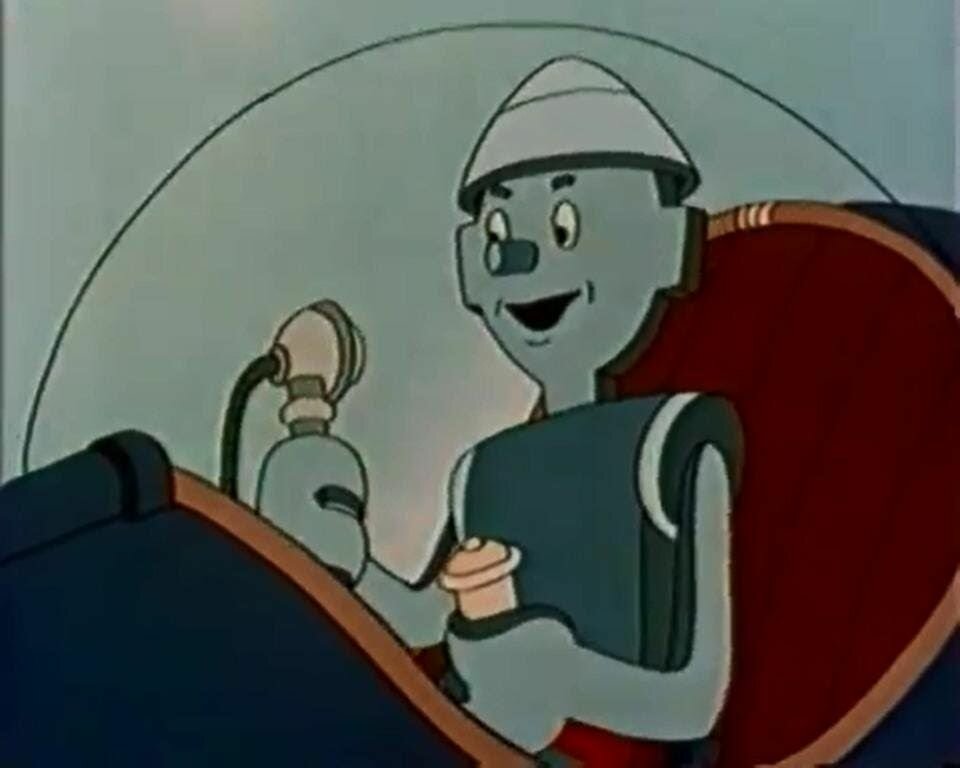
The first cartoon with his participation - “The Adventures of Samodelkin” was released in 1957, and later Bakhtadze made many more films with this hero, the last dating back to 1983. You can’t say that these cartoons became very popular, but the first made quite a stir, and even won an award at the 1st All-Union Film Festival in Moscow.
I note that there were enough animators among the employees of the "Funny Pictures" - the same Sazonov was a very famous production designer and for many years taught at VGIK the skill of an animated film artist.
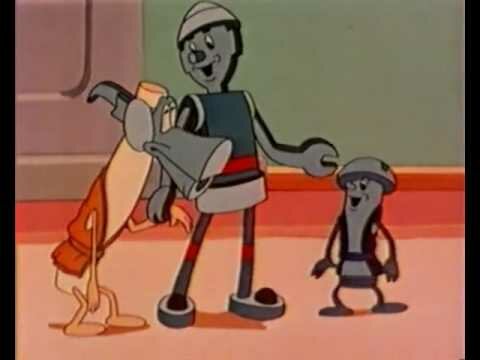
It turns out an amusing chain. In 1957, the Georgian "Adventures of Samodelkin" receive a prize, and in 1958 in the "Funny Pictures" appears his own Samodelkin. But also - a fun robot assembled from details.
It seems that the magazine simply borrowed the name and idea of the character from the Georgians, but they came up with their own visual image.
And do not rush to stigmatize anyone - do not forget that in the Soviet Union there was a special attitude to copyright. On the one hand, copyrights were respected to a certain extent, money was strictly accrued for the use of someone’s works, even restaurant craps made accurate contributions to the authors of songs performed in taverns.
On the other hand, exclusiveness of rights was not at all welcomed.
It was impossible to say: "Cheburashka is only mine, bring me the money, and without a contract with me, do not dare to use it!" Successful finds were officially officially replicated at all levels and in all spheres, and, for example, confectionery factories produced Cheburashka sweets without asking anyone or paying anyone anything. Simply put - you will always be paid for your specific book, but the character you invented is a national treasure. Otherwise, Chizhikov with his Olympic Bear would be the richest man in the Soviet Union.
One way or another, Samodelkin immediately became a full member of the club.

I note that the image was not fixed immediately and at first varied a little. For example, Samodelkin, drawn by Migunov for the first animated film about the Club of Cheerful Men called "Exactly at three fifteen," is somewhat different from the original.
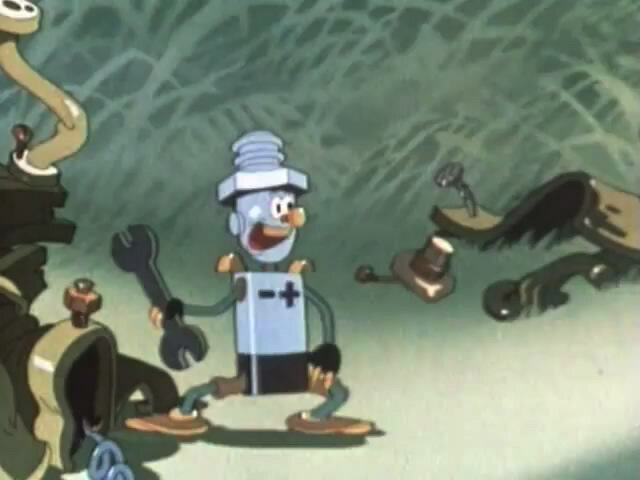
Samodelkin quickly gained popularity and even got his own column in the magazine.

In general, the robot turned out to be a very successful find for the children's magazine, and other publications followed the example of “Funny Pictures”. In the journal "Pioneer", for example, in the early 60s there appeared its own robot-leader of the column named Smehotron.

The last question remains - what does Yuri Druzhkov mentioned in Wikipedia have to do with the image of Samodelkin?
The correct answer is novelization.
The fact is that of the entire composition of “funny little men” only Pencil and Samodelkin were not heroes of literary works. And then the editor-in-chief of "Funny Pictures" (and the creator of the Pencil), Ivan Semenov, invited journalist Yury Druzhkov to write a fairy tale with the participation of his favorite characters - about how books are written today based on popular films.
In 1964, the story “The Adventures of the Pencil and Samodelkin” was published, illustrated by Ivan Semenov himself.

The second book - “Magic School” was published after the death of the author, and in our time, the writer’s son, Valentin Postnikov, put the production of the adventures of Pencil and Samodelkin on stream.
The last thing I want to say about - Samodelkin was probably the most popular of all the characters of the Club of funny people.
It is used today in the tail and mane by everyone who is not lazy.
Samodelkin is “an online store of steel containers ”, it is “ everything for low-rise construction ”, it is “ sale of garden gasoline and electrical equipment ”, it is “ wholesale and retail trade in building materials, fasteners and tools ”, it is “ development and sale of electronic ignition systems and schemes for outboard motors, "this is" the largest trading platform for the purchase and sale of handmade-works and designer things "- and all this is only from the first page of the issuance of Yandex.
But, probably, the most unexpected use of this name was the experimental psychedelic film “The Way of Samodelkin”, shot in 2009 “based on the text of the same name by the Inspection“ Medical Hermeneutics ”artistic group (P. Pepperstein and S. Anufriev).

Movie frame
But the arrival in the "Funny Pictures" of artists who created "modern art" is a different story.
PS When this text was already written, thanks to the famous animation historian Georgy Borodin, there was a “missing link” to this investigation - the comic strip “The Story of a Stranger” from my June issue of Funny Pictures (No. 6, 1958).
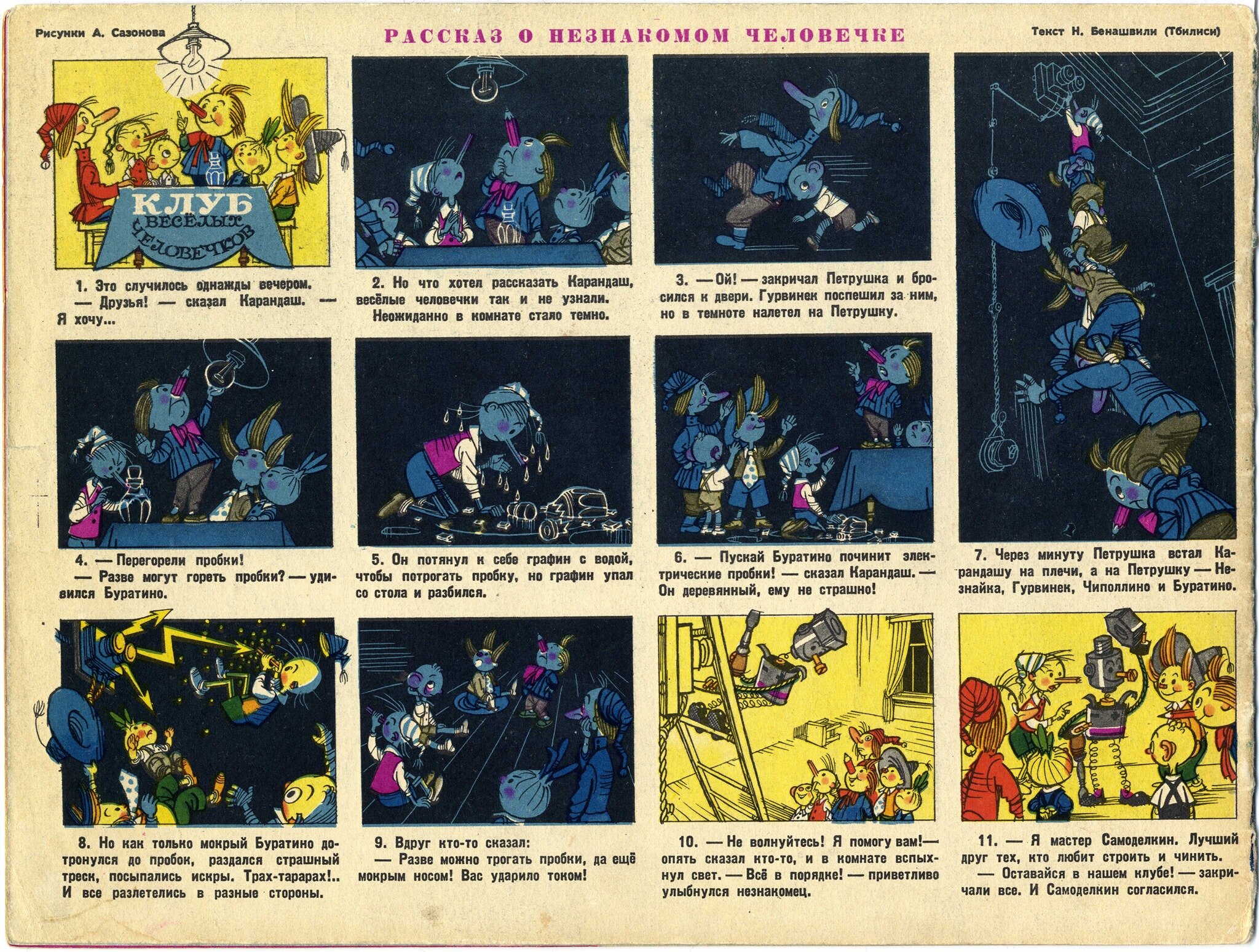
As you can read, having examined the fine print, the artist is Anatoly Sazonov, and the author of the text is Nina Benashvili. The same Nina Ivanovna Benashvili, who, being a full-time scriptwriter of the Georgia-Film studio, wrote scripts of all Vakhtang Bakhtadze's cartoons about Samodelkin.
And which, apparently, is the real author of the character, assembled from the details. The same name was called Halmarjwe Ostate in Georgian (literal translation is “right-handed master”), and in Russian it was simply called Samodelkin (by the way, it’s a very common Russian surname. Not the most common, but recorded at least from the end of the 19th century).
So the correct answer to the question from the title will be the following: Samodelkin from “Funny Pictures” is a half-breed, he has a Russian father and a Georgian mother. And with Samodelkin from Georgian cartoons, they are maternal brothers.
PPS When one of my friends read this text, he stated the following, I quote: “I once had the opportunity to talk on one resource with an Indian (or, more precisely, Tamil) from Madras. He had a favorite Russian book translated into Tamil in childhood, about Pencil and Sambarakarma . I must confess that I didn’t immediately get a grasp of what this book is and who Sambarakarma is . A guy complained that the book had long been lost, and he would love to buy a translation, if not in Tamil, then at least English, to read to his daughter already, but, unfortunately, it seems that Druzhkov’s books are not being published abroad now. But it turns out that they were published even in India. ”
So, Sambarakarma was added to the company to Samodelkin and Hellmargve Ostate. Interestingly, were there any other options?